In the previous post about keyword research for startups, we checked out how this SEO research changes according to your startup’s stage of growth.
With that context, you can now quickly do your own keyword research to arrive at any of the outcomes that apply to your startup’s stage of growth.
Sign up for a tool like Ahrefs, SEMrush or Moz
Trust me, it’s worth the few hundred dollars this will cost you. A Standard Ahrefs plan (about $179 per month) is more than enough for most startups, since these tools are only your starting point. The real work happens in your spreadsheets – where you’ll line up, cluster, pivot, and prioritise terms. Beyond that, once you start implementing this keyword research, your SEO needs could shift to more in-depth keyword tracking tools, especially if you have a large scale/ high growth website, such as Dragon Metrics, and log crawl software such as Deepcrawl, Oncrawl or Screaming Frog.
For now, stick to the simple tools – because what you need is a quick understanding of
- whether search demand even exists for your product, and if it does
- are people who search with these terms willing to pay for what you’re offering.
Fire up the keyword explorers
I’ll use a hypothetical product that helps companies build remote, diverse and inclusive teams. Let’s call it the OneTeamBuilder (never ask me to name your product).
OneTeamBuilder integrates with job engines such as CareerBuilder, Glassdoor and Indeed – and others across the globe. It also integrates with startup ecosystem communities such as AngelList, CrunchBase and Product Hunt.
Its core feature is a dashboard that tells hiring managers how many diverse candidates have viewed and/or applied for their jobs and therefore how diverse their hiring pipeline truly is.
The goal is that over time the startups can improve on whatever needs improving to build a more diverse team. This could be a hiring score or a live dashboard as the startup grows – featuring insights into how they’re performing for hiring focused on building equity for truly diverse candidates within an inclusive hiring ecosystem.
As the SEO looking into how to tackle this gigantic task of putting OneTeamBuilder in front of the right audience on search, I’ll kick off Ahref’s Keyword Explorer and add some keywords that sort of fit the bill for OneTeamBuilder; such as – remote jobs, hiring software, and diversity hiring.
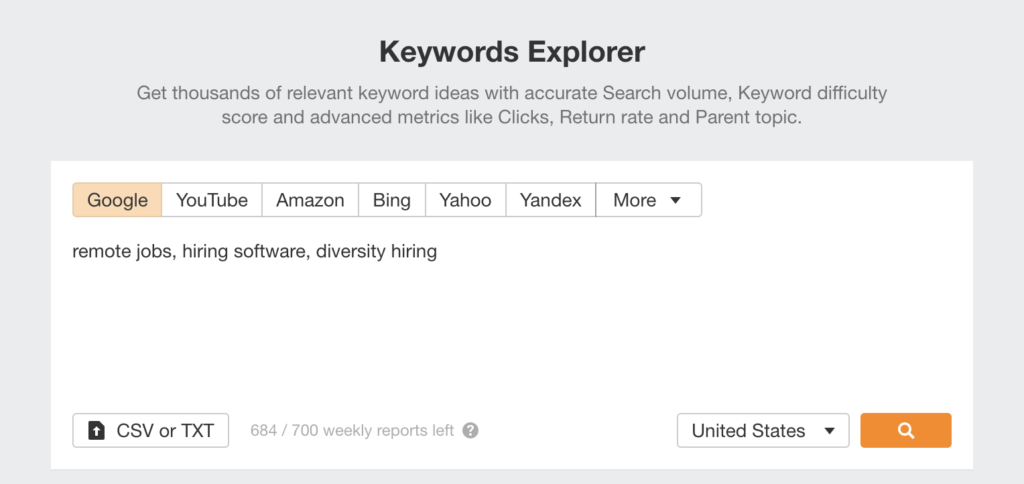
Browse the keyword results and save the ones you want to explore further
This initial search already gives me some early learnings such as:
- ‘Remote jobs’ has a wider search profile, i.e., higher search volumes
- ‘Hiring software’ has a lower search profile, however a much higher CPC.
- ‘Diversity hiring’ is a longtail phrase and likely has other variations that are commonly used
For now – I need to build momentum from candidates who are likely searching for ‘remote jobs’ and also from hiring startups who are likely searching for ‘hiring software’. So both terms are relevant to me and this quick search has told me there’s an appetite for both on search.
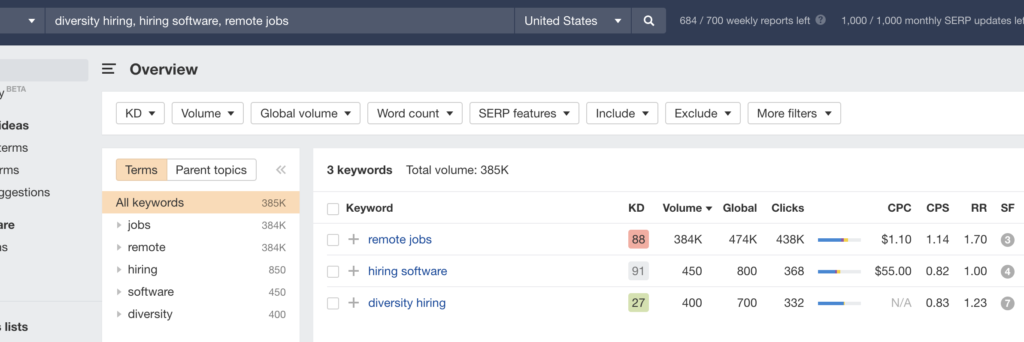
Manual search to check relevance to my startup
This is where a VPN can be handy if you’re very curious about each English market. For now, I’ll just use my AU location to vet these keywords for the Australian market.
Here goes…
As predicted ‘remote jobs’ is low value (no ads, atleast in AU) but high demand (we can also tell this is a competitive keyword phrase by looking at the column KD (Keyword Difficulty) in the screenshot above; a KD of 88 is pretty high). Interestingly, even with the term ‘remote’ in these phrases – I can see a lot of location focus in the results which could form a hypothesis that people want remote jobs in their time zones.
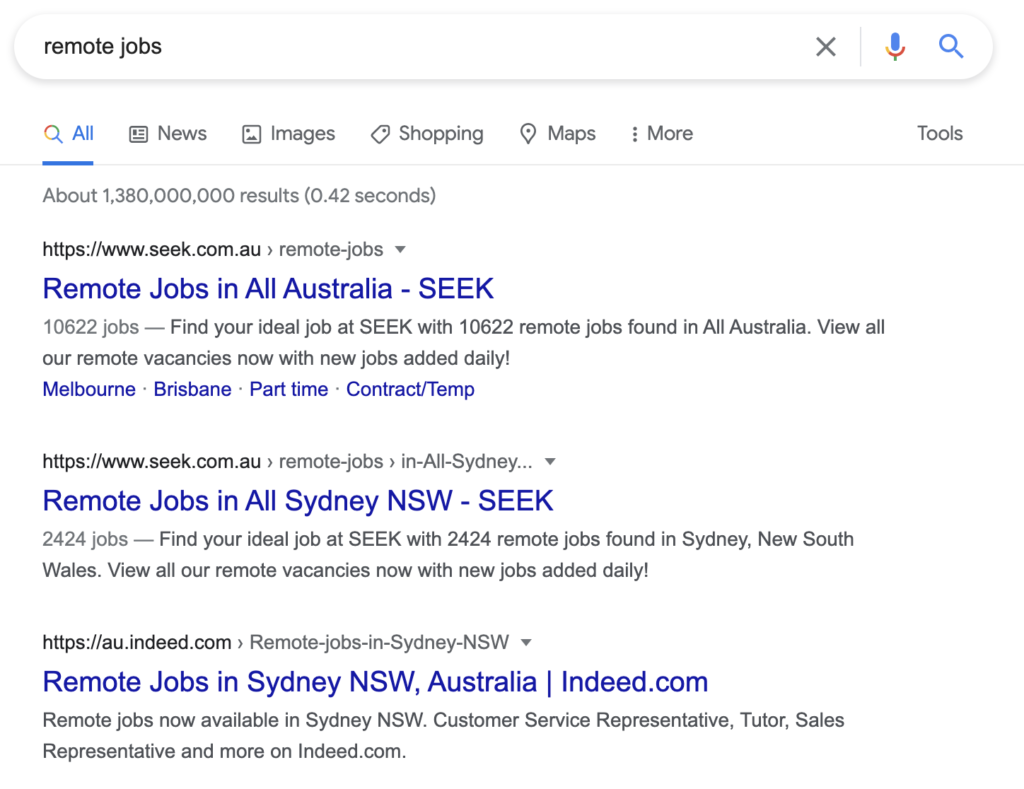
And as expected ‘hiring software’ results in lots of ads (high ticket value).
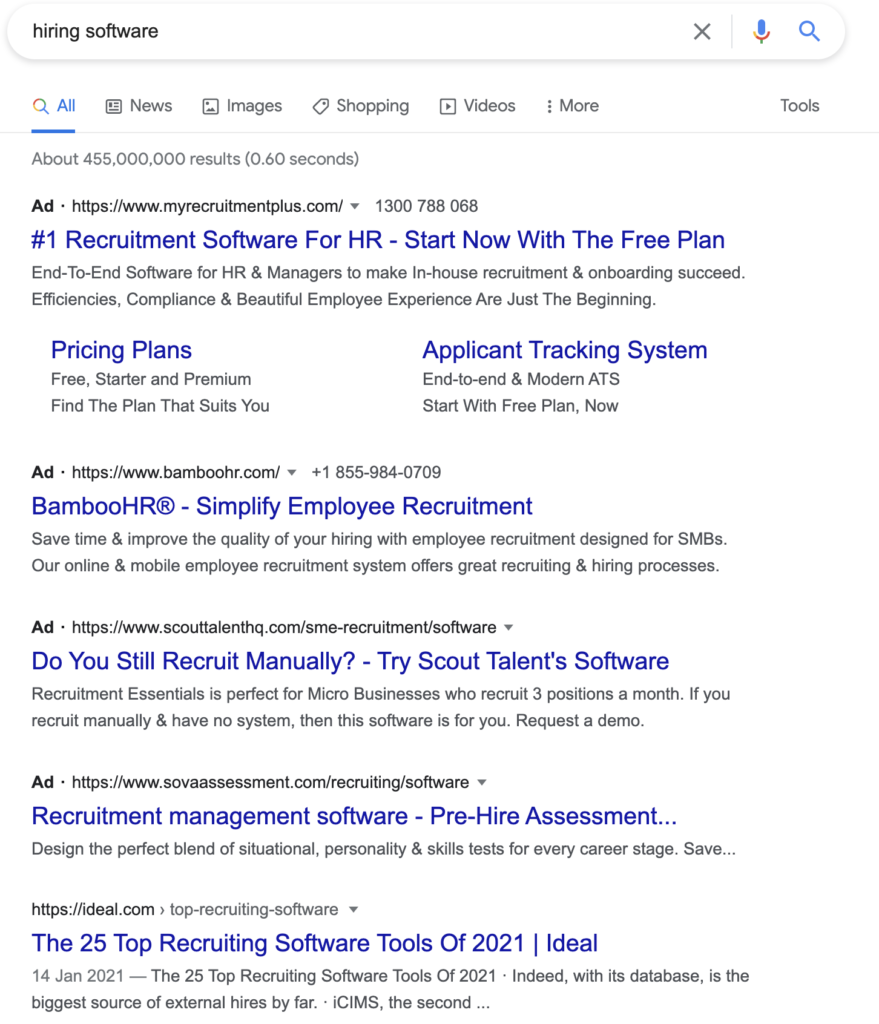
When I move beyond the ad wall, I see two types of results:
- Articles that compare hiring software (which is common when you search for any ‘intent’ + software term) – this is reinforced in the People also ask section (ex: what is the best…, which hiring platform, what software). We can hypothesise that Google understands this term’s intent as exploratory – which relates to the ‘consideration stage’ in a buyer’s journey.
- Workable.com – a hiring software that should give its SEO team a raise.
And understandably Workable has organic visits of about 700,000 per month (remember to take these Ahrefs or SEMrush numbers as indicative of any website’s search performance trends give or take 20%).
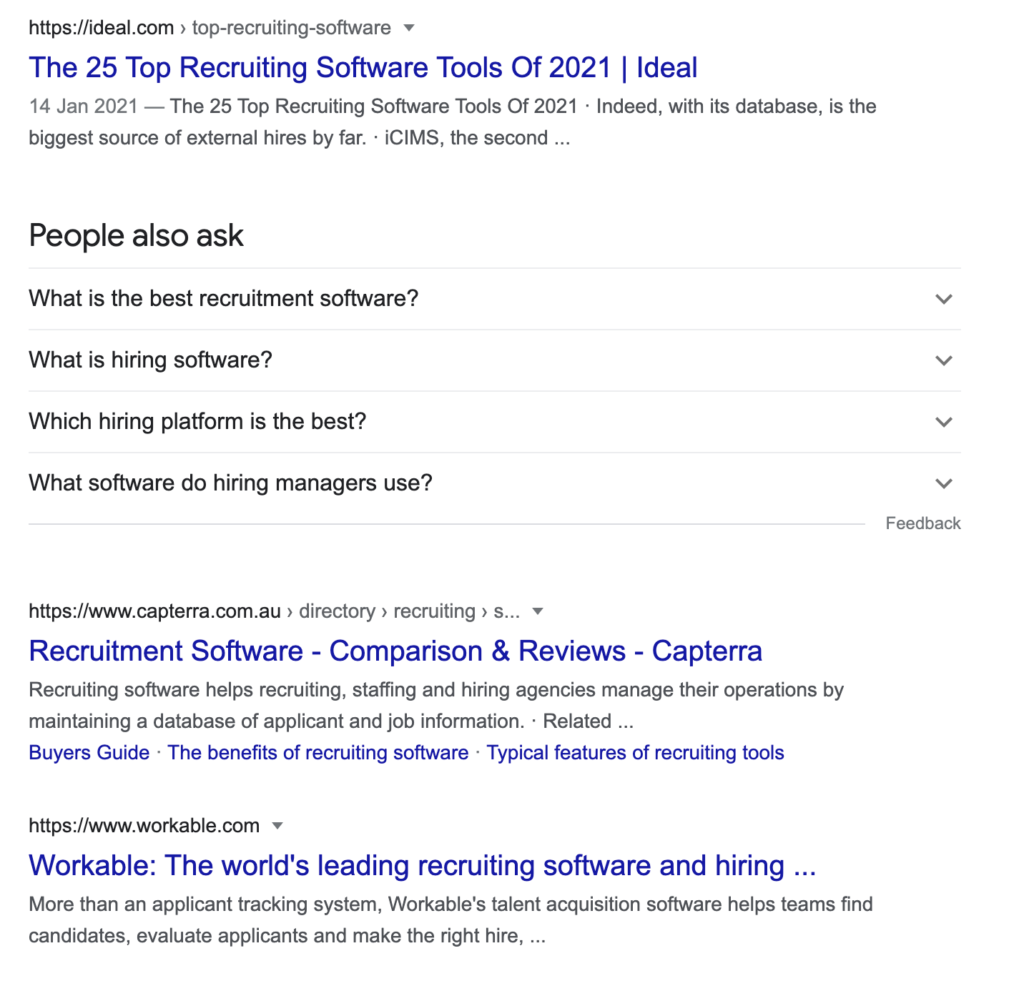
When I repeat this step for ‘diversity hiring’ I get a similar ads + organic content search results page. However, when I click on these ads (sorry SEM managers) I can see the top results aren’t exactly about diverse, inclusive, equity hiring. They’re bidding on these adwords. Most likely ‘diversity hiring’ is part of their Adword scripts as part of a bigger group of terms that are bucketed under a ‘hiring software’ ad targeting strategy.
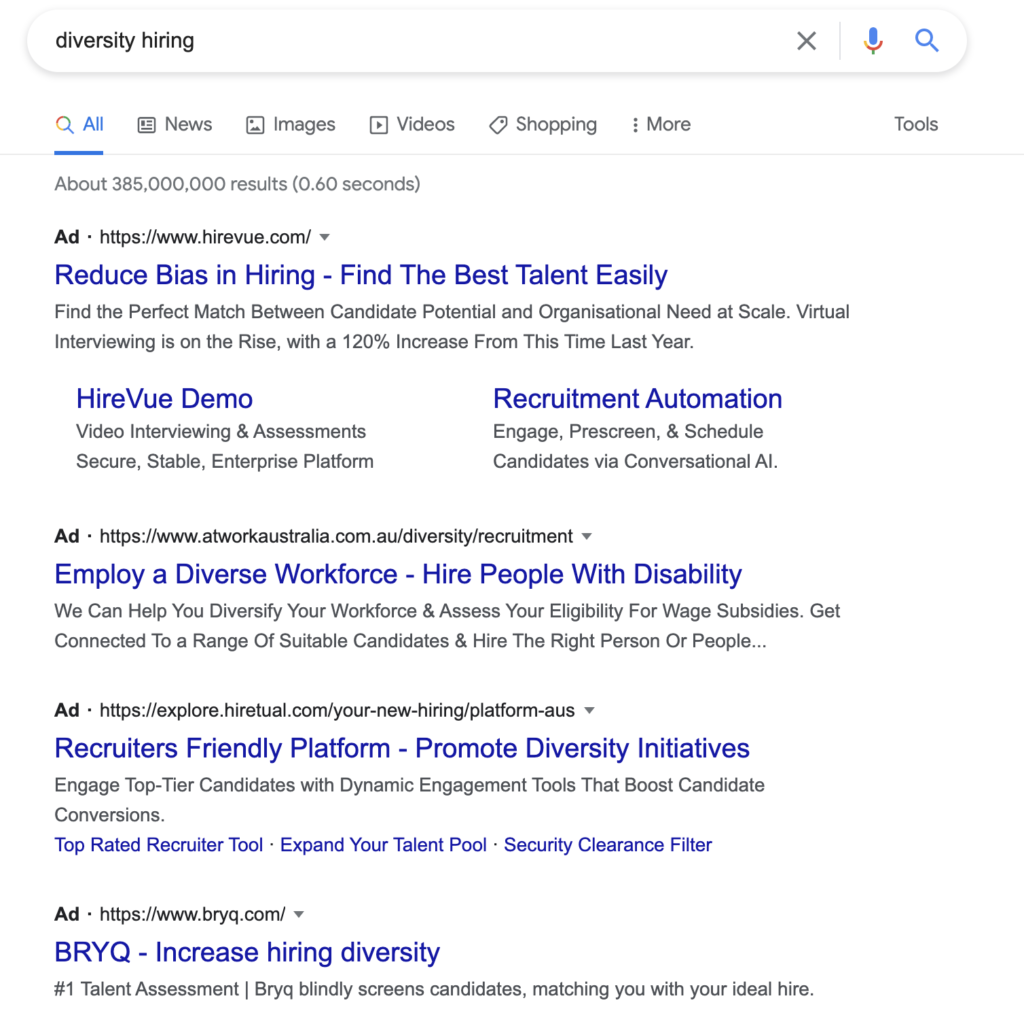
Again, when I move beyond the ad wall, I see three types of results:
- Articles that explain what ‘diversity hiring’ means
- Guides for how to hire diversely
- And interestingly – a ‘people also ask’ section that targets awareness about diverse and inclusive hiring processes
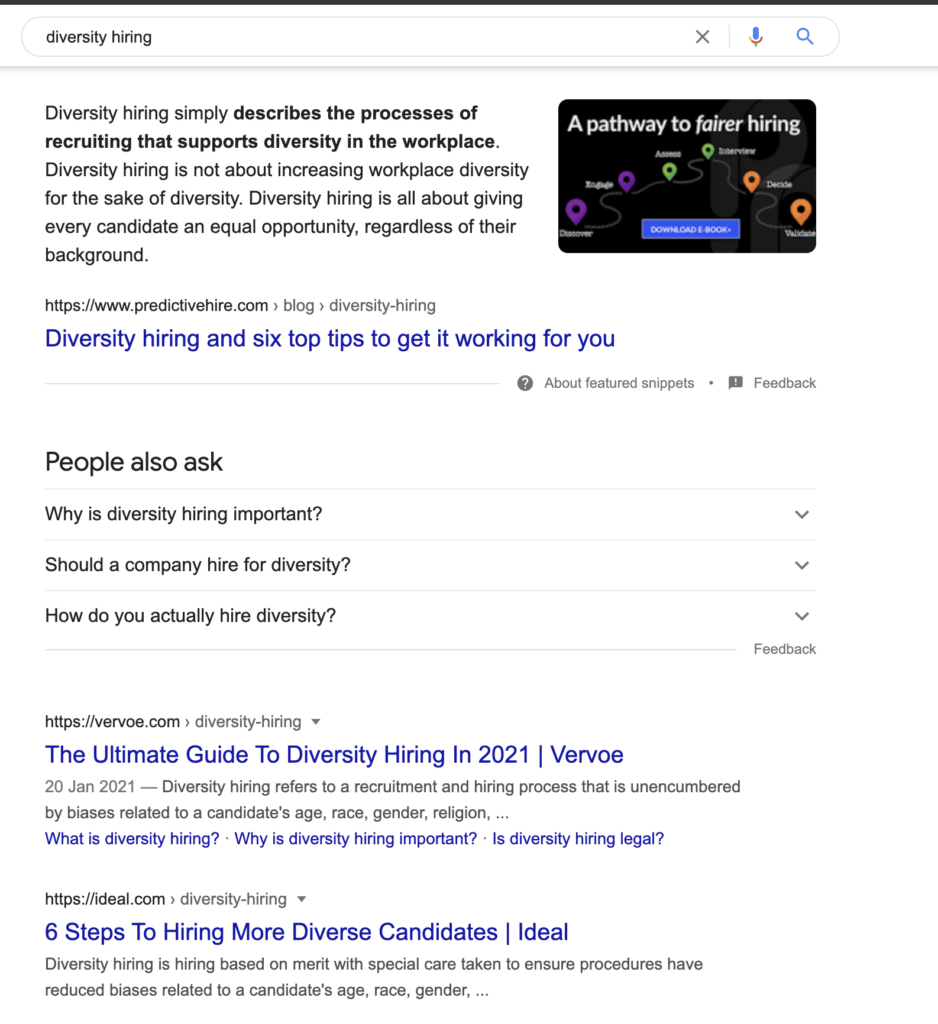
At this stage my takeaways for SEO direction are:
- I have the right keywords to drill deeper
- Each keyword represents a separate organic growth strategy
- Timezone focused remote job listings for candidates: high volume SEO pages backed by the standard tier of a search results page (search listings) + individual job pages
- Hiring software positioned for diversity in hiring esp for startups: flagpole landing pages (homepage + feature pages)
- Evergreen awareness-building content for diversity
- I would also throw in remote work guides (remote versions of traditional work cadences such as workshops, brainstorming, team updates, etc)
Prioritise the first term – and get an early idea about SEO outreach
Yes link outreach. I apologise in advance to everyone who thought it’s dead. There are three types of link outreach in today’s world:
- Reputation building link outreach: Think PR. Which, yes is all online, but still needs some nuance to count toward your website organic growth. At launch, your PR cycle would likely be about your brand and founding team. However, this could be well complemented by product + brand outreach that puts your SEO pages squarely at the centre of everything. Why is this relevant? Because over time you’ll build strong recall for your product against key terms that you want Google to rank you for.
- Social media paid outreach: This is very similar to PR outreach, but is simply positioned in ads on social media that are likely to reach your audience super quickly. It’s the same principle of helping people associate your brand with a type of product or theme that interests them.
- SEO outreach: or as we used to call it ‘link building’. I’ll write about why I prefer to use the term SEO outreach over Link building another day, but this type of outreach is essentially about writing to influencers (website owners, writers, authors, etc – anyone with an audience through their website) and telling them about your product. Some might link to you, most will ignore you. But even a success rate of 5% after writing to 800 people (hello personalised automation mail tools) will go a long way in helping your website rank for your preferred terms.
At this stage, I recommend re-grouping with your founders, product and PR people and pitching these themes to see which one is already part of their roadmap for product positioning and PR, and which isn’t. Align with their plans and you’ve got your first SEO outreach campaign.
In summary
These five steps are just the tip of the iceberg. The goal here was to understand very quickly – your product’s organic landscape and how you can approach it.
Simplicity is key and going after one or at the most two key benefits to inform your startup’s SEO – till you hit traction – is a good start. How deep you can go for each benefit will depend on how deep your product category is in terms of search demand and awareness.
- If there’s a strong appetite for it in search – then you could go deep into related concepts.
- If there’s a strong appetite for different angles to it – then you could go horizontal into similar jobs to be done
- If there’s very little demand for it – then you could build that awareness with short term levers like ad targeting that feed long term gains like creating search volume for a new category.
Whichever path you choose as the right one – make sure you work in synch with product or founders so that your organic footprint drives the right kind of growth.